#eastern shaman
Explore tagged Tumblr posts
Text
#witches of color#witchblr#shamanism#cultural appropriation#closed practices#history#tungusic people#eastern spirituality
247 notes
·
View notes
Text
Eastern Screech Owl Prophecy And Symbolism
The Following Channel is from higher powers, Divine, the ancestral plane and is prophetic through Quornesha S. Lemon|
Whether the Screech Owl appears in dreams, visions, waking life or synchronicities, it is a sign and message that a Plethora of storms are coming. These storms will take direction and skip the chosen ones. Tornadoes massive. Touch not my anointed and do my prophets no harm. (Ye are the salt of the earth.) The Screech Owl is a message to prepare for God/Divine supernatural occurrences to take place. These storms will be both natural and supernatural. These storms will be huge. It is time to salt your path, your property, your surroundings. The Anointed/chosen ones will know exactly where to place the salt. Like the Israelites, placed blood on the doorposts, you will know what to do when these storms are near. There will be lightning storms and darkness in the day time. However, no harm will come to you nor your household.
This will all occur when there’s a Switch of power. Lower cost of living. A balance to the real estate market. Laws changing. Army men like martial law. But it's not enforced. They're there to protect and guard. Once these storms do what's necessary they will leave. 12 tornadoes at once. Trees uprooted. The Eastern Screech Owl is symbolic of some turbulence about to take place. Loud sounds from nature, massive, historic storms are on their way. There will be People still in their homes, and some areas are destroyed. These storms will touch down in some of the biggest cities. They will be separate but then the energy will compile together into one, in at least one of the major cities. I see magnitude of T8-T11
Your home will be your shelter. There won't be much power outage. These storms will be sporadic. And toxic family will look to you for shelter. Don't do it. Don't do it. Don't do it. Don't let these people stay one moment in your home. The family members who will seek shelter in your home are dealing with manic, schizophrenic, psychotic tendencies and it is important that you not shelter them. Let them seek help where they can be assisted.
Salt the four corners of your home/land. One moment a tornado is down the street and it will jump three blocks over and tare up the town and the storm will not come near you or your household. I see buildings split in half. And still standing. Homes still standing whilst buildings around them are torn apart. After the storm there will be rainbows, full circle rainbows all about. Rings in the skies. Pillars of light appearing in clouds. Flowers blooming. The earth is shifting. This isn’t to scare anyone, perishables, and stocking up on supplies will not be necessary, as a I see resources still available. But you’re welcome to do so if you feel led. The Chosen will see dreams and visions of how to lay the salt upon their properties. These storms will seem apocalyptic. And after a 5 day period, there will be rest. These storms will hear the voice of God (touch not my anointed, and do my prophets no harm) and they will reroute)
The Eastern Screech owl prophecies of things finally flowing in your direction. It is the ultimate destiny swap from the universe. The tables are turning, and those who’ve used your energy to get ahead will begin to pray for forgiveness and praying for your success instead. They will do so hoping for something in return and will receive nothing. The 144,000 are tribes of people, not simply individuals. So, if you are being called to lead, you will bring many people along with you. You may even expand a ministry, or mentorship/coaching business/practice. Supernatural events are about to occur. The warnings are over, a time of action is upon us.
The Screech owl is prophetic of God/Divine making a noise about you. Your voice leading many people. These are prophetic times. And the chosen ones will speak. It is is symbolic that God/Divine listens. These storms will reduce the arrogant and proud. (How long shall the wicked triumph, How long shall they utter and speak harsh things) Ps. 94. Watch Divine humble those who have harmed/blocked you over the past years. Nature will obey. Something Historic is about to take place.
This message isn't, obviously resonant with all whose paths it crosses, as perhaps you may encounter someone of this vernacular, mastery or skill. Therefore, it is a sign from the universe that you're meant to work with such a person.
Need further clarity or your own queries answered? Book your own reading as my schedule is full and I do not guarantee a reply on social media regarding this post.
If this is not you, then it is time to get clear to rejoin your tribe or the rest of the world of infinite beings. It's time to bring your light to the forefront. However, if you aren't able to invoke, heal or otherwise on your own, call on the assistance of shamans, healers, intuitive people, etc. to assist you. This synchronicity can possibly have specific meanings for you, it's time to get insight.
The Gift that Quornesha Has can never be duplicated, She is a Shaman, Writer, Healer, And Teacher with incredible prophetic/healing gifts. Please do not infringe upon her rights as the author. You are not permitted to reuse, nor are you to sale as you wish. This information has been made available to you for the purpose of introduction and demonstration. All rights reserved. If you'd like to use this in a magazine, online publication, or other, please ask for permission first. Legal actions will be taken if you proceed to impose. Be blessed, bless others and be at peace on your journey. What you do is coming back on you. Make sure that it is good, and all is well within you, through you and around you. The source sees all and knows what you think it does not.
#shaman#mystic#prophecies#priestess#high priestess#shamanic healer#healer#mysticism#prophet#scribe of divine#god#God#Goddess#High Priestess#Prophecy of Eastern Screech Owl#Screech Owl#Owls#Owl#Symbolic meaning of Eastern Screech Owl
2 notes
·
View notes
Photo



Transformation into therianthropic form and the appearance of dead ritual practitioners and mythological beings in therianthropic guise are associated with the ‘Great Dance’ a term used to describe what is variously described as the curing/medicine/healing/trance dance that is practised by most Ju, Khoe, Taa and !Ui language family speakers (Blundell 2004). Painters picked out correspondences between the swift behaviours I have listed, on the one hand, and aspects of the Great Dance, on the other:
• Circusing behaviour involves a wheeling, roughly circular pattern in which the birds follow each other, with individuals and pairs breaking off from the swirling mass of birds and then rejoining them. The Great Dance is typically circular in form, with dancers following behind each other in procession People join and leave the circling dancers from time to time.
• The aerial displays of swifts while circusing and the manoeuvres carried out when two or three birds are performing courtship acrobatics are carried out at high speed with sudden changes in direction. These behaviours may have their equivalent in the frenzied behaviour of Bushman ritual practitioners in ecstasy, who may unpredictably run out from the circle of dancers into the veld. In such cases one or more people will follow the individual and bring him back to the fire.
• Swifts utter characteristic screaming sounds while circusing (Lack 1973: 129). Bushman ritual practitioners scream or imitate animal calls when extracting and expelling sickness from theirownbodies (Bleek 1935: 4; Lee 1968; Marshall 1969: 372; Katz 1982; Biesele 1993)
• Circusing usually commences at dusk and may continue until dawn the next day (Lack 1973; Chantler 1999), as is also FIG. 3. (Site 10). The imagery at Ezeljagspoort (Site 10) is the most renowned of the ‘mermaid’ sites. The lower limbs of most of the images are short and splayed and appear fish- or bird-like. Image A is a long attenuated figure that /Hankasso called ‘the rain’s navel’. Image B holds a short stick-like object. The images below (C) he called ‘rain’s sorcerers’. They follow each other in a horizontal procession. George District,Western Cape Province. Image B measures 70mmfrom crown of head to right-hand-most tail tip. Paintings in red. (Copy by T.A. Dowson.). typical of Bushman dances (Marshall 1969);
‘Swift-people’: Therianthropes and bird symbolism in hunter-gatherer rock-paintings, Western and Eastern Cape Provinces, South Africa by Jeremy C. Hollmann
#therianthropes#archaeology#anthropology#petroglyphs#shamanism#therianthrope#rock painting#south africa#trance#rock art#san people#shaman#ritual#transformation#eastern cape#western cape#ornithomorphs#zoomorphic#zoomorphism#hunter gatherer#birds#my upl
7 notes
·
View notes
Text
Album Review: HELL:ON - Shaman (Archivist Records)
HELL:ON, Ukraine’s leading Atmospheric Death Metal band, will release their seventh full-length album, Shaman, on May 17th, 2024, via Archivist Records. HELL:ON was formed in early 2005 in Zaporizhzhia, Eastern Ukraine and they play death metal with added oriental and tribal elements. The band’s lyrics generally deal with mysticism, philosophy, and anti-religion. During the recordings of previous…

View On WordPress
#Andreas Kisser#Andy LaRocque#Anton Vorozhtsov#Archivist Records#Atmospheric Death Metal#Death metal#Eastern Ukraine#HELL:ON#Hellion#Jeff Waters#Kreator#Leshiy#Marduk#Marek Pająk#Napalm Death#Olexandr Bayev#Rotting Christ#Shaman#Slayer#Ukraine#Zaporizhzhia
1 note
·
View note
Link
#ultra rare#collectible#antique postcard#eBay#Witch - shaman#Tunguska#Eastern Siberia#Tsarist Russia
1 note
·
View note
Text
Marvel’s Lives
As you guys know, there have been previous champions. They’ve all lived different lives and such. Some have been men, some women, and are some genders that don’t exist anymore. Point is, no one life is the same.
Let’s say some female heroes are talking about abortion one day and out of nowhere Cap just chimes in:
Marvel: “Oh yeah, pregnancy is tough, man. Giving birth is not for the weak. I’m speaking from experience here. Anyone who doesn’t want that, shouldn’t do it.”
Female JL members: “What…?”
Black Canary: “Marvel, last I checked, you were a man.”
Marvel: “Actually, a few thousand years ago, I used to be a woman!”
Female JL members: “???”
Marvel: “I’ve been a woman, multiple times actually.”*proceeds to walk away like he didn’t drop that on them*
They’re all thinking he’s trans, but no? His words imply he’s fluid? The thing is though is that Marvel’s never really shown that he’s either. The question was later asked by Hawkwoman when he was making oobleck in the kitchen of the Watchtower
Hawkwoman: “Captain.”
Marvel: “Yes, Ms. Hawkwoman?”
Hawkwoman: “Are you a woman?”
Marvel: *looks up from his oobleck to her, looking confused* “No? Why?”
Hawkwoman: “Some of the other girls were talking about how you were a woman at some point.”
Marvel: “Ooooh that. I was a woman. Yeah.”
Hawkwoman: “So you’re not anymore. What did you look like as a woman, if I may ask? Also what is that?” *points to the oobleck*
Marvel: “Oobleck.” *offers bowl off oobleck to her for her to play with* “Also, sure. Just a sec.” *mutters a spell*
Hawkwoman: *pokes the oobleck*
Marvel: *poofs and is now a female champion from like seven thousand years ago. His suit also changed to the previous champion’s own suit* “Tada!”
Hawkwoman: *does a double take when she sees him* “You… Certainly have a darker complexion.”
Marvel: “Yeah. If I remember correctly, I lived in the Middle Eastern area back then. That’s probably why.”
Hawkwoman: “And why are you white now?”
Marvel: “My appearance changes every few a hundred years or so. That includes my skin color, gender, and other features.”
Hawkwoman: “Oooooh. Okay then.”
They proceeded to play together with the oobleck after that.
Like ten minutes after that initial interaction…
WW: “Shayera. There you are. I was wondering if you wish to spar with me.” *notices Marvel* “Who is this? A new hero?”
Marvel: *turns around, hands covered in oobleck*
Hawkwoman: *also turns around, hands covered in oobleck* “What’d you say? I was distracted.”
WW: “I was wondering if you wanted to spar with m…” *trails off when she sees Shazam’s lighting bolt on fem Marvel* “Brother?”
Marvel: “Hi, Ms. Wonder Woman.” *waves an oobleck covered hand*
WW: “Why’re you a woman?”
Marvel: “Ms. Hawkwoman asked.” *shrugs*
The three then proceeded to play with the oobleck together.
Then, there was the time someone asked Marvel about his religion when they heard he believed in the Greek Gods.
Marvel: *shrugs* “I’ve been multiple different flavors of pagan. Fun fact, a couple thousand years ago, I used to be a ritualistic cannibal. It was apart of the offerings and rituals of a shaman. Or at least the types of shamans of that time in that specific empire.”
JL member: “Do you still eat people now?”
Marvel: “That’s not important, the point is, if there’s a religion, I most likely at some point practiced it. Or at least the super old version of it.”
JL member: “Okay? But do you still eat people now??”
Marvel: “I guess I’m saying I’m kinda in between religions?”
JL member: “Can you please stop ignoring the questioning ?”
He continued to ignore the question.
Of course, the ritual cannibal thing isn’t the only one of the outlandish things Billy’s casually admitted to doing. Eventually though, things can get a little bit too much for some members.
Marvel: *telling them about another thing he did in a past life*
GL: “Okay! That’s enough, dude!”
Marvel: *concerned* “What? Did I say something wrong?”
GL: “No, I’m just confused as to why you’ve done all these things, man. Are these like side quests you under go? Or like…? What’s going on, pal?”
Marvel: “Nothing…? These are just things I’ve happened to do.” *shrugs*
GL: “So you’re willingly telling me you tried to trample someone to death with a horse just for funsies?”
Marvel: “Well, when you put it like that-”
Flash: “Wait, what about the time you told me you were a princess before princesses were a thing?”
Marvel: “I uh-”
Superman: “And the time you told me that you used your lightning powers to become a cult leader?”
Marvel: “Okay, I get it. I’ll stop tell you guys about myself.”
MM: “Captain, it’s not that we don’t want you to tell us about yourself. It’s instead that your stories seem to have no cause for them.”
Flash: “Yeah! Like why did you feel the need to become a cult leader? How were you a princess?? Why would you want to trample someone with a horse???”
Marvel: *shrugs*
Flash: “Wha- Don’t just shrug!”
Marvel: “I was a different person back then.”
Superman: “That’s a little too cryptic, bud.”
#billy batson#captain marvel dc#dc captain marvel#shazam#fawcett comics#fawcett#fawcett city#black canary#dinah lance#hawkwoman#shayera hol#wonder woman#diana prince#green lantern#hal jordan#wally west#the flash#superman#clark kent#martian manhunter#j’onn j’onzz
756 notes
·
View notes
Text

Hello and welcome! If you're new here or unsure what this is all about, this pinned post is for you. Please read before descending.
TL;DR: I post yandere/horror/monster self-insert stories and (mostly) funny doodles. Yes, I'm over 18. Any pronouns.

Most recent work(s): Yandere!Prison | Monster HOEtel Comic
Current Game Project: Cozzmos Hotel (Monster Dating Sim)
Tag Navigation: #personal (Rambles & Asks), #doodle (Everything I've doodled), #my art (Curated, higher quality doodles), #mail doodle (drawings received from other people), #advice (tips, suggestions etc. to questions I've received)
List of Anons: 👘,🧥,🪐,🌚,💫,✨,👾,🎪,🎭,🔮,🧸,💥,⚠️,👁️,🦷,🎐,🪽,🫧,🌟,☁️,⚡️,❄️,🌊,🪷,🌼,🌷,🌸,🌹,🪻,🎀,🧌,👽,💀,👻,🎃,👨🦲,👶,😇⭐️,🧼,🧋,🧃,🍊,🍬,🍡,🍰,🍰💥,🍞,🍮,🍙,🫘,🐼,🐯,🦊,🐰,🐶,🐺,🐲,🦄,🐍,🦇,🦆,🦢,🐈⬛,🦝,🐇,🐀,🐘,🦭,🦐,🦀,🐋,🦈,🐝,🪲,🦋,💙,❤️🩹,💕,🧭,📖,🪤,💸,🦠,🎶,♠,💠 anon (I'm coming for you), (my wife anon), hand-biter spouse, pick up line anon, wifey anon, GYAT anon, eastern dragon anon, introvert anon, super eepy anon, goopy slimey anon, yippie anon, blue anon, green anon;
Other links: Ko-Fi | Redbubble | Discord (Info here) | X
Disclaimer: All images are either credited, my own work, or AI generated (Midjourney) if no source is mentioned.

Request Status: Closed for now! Short asks are ok.
Rules: Anything within common sense is alright. I'm not good with graphic, detailed smut, but limes are ok. Female/male/gender neutral readers. Original work and fandom (see below).
Fandoms: [Anime: Baki, Hakuouki, Inuyasha, Jojo’s Bizarre Adventure, Mayoiga, Monster, Naruto, Shaman King, Yu Yu Hakusho]; [Manga/Webcomics: Killing Stalking, Crows/Worst (Takahashi Hiroshi), Suicide Boy, JTHM]; [Games: Hogwarts Legacy (or Harry Potter), Obey me!, Legend of Zelda: BotW + TotK, Silent Hill, Call of Duty, Baldur’s Gate 3]; [Misc: Alien (& Predator), Horror Movies, Creepypasta, Star Trek: TOS]

Baki:
Complete list here
Horror:
Complete list here
Original Works:
Complete list here
Monsters:
Complete list here
Boku no Hero Academia:
BNHA Headcanons: Midoriya Izuku as a loving boyfriend
BNHA Characters x Artist! Reader
BNHA Headcanons: Pro-Hero Todoroki Shoto x Reader
Hakuouki:
[WIP Request] Yandere! Hakuoki x Reader (Demon Trio)
Inuyasha:
Inuyasha/Sesshomaru x Butterfly Demon! Reader Headcanons
Inuyasha/Sesshomaru x Butterfly Demon! Reader Headcanons: First meeting
Inuyasha x Reader Headcanons (lime)
Monster:
[WIP Request] Johan Liebert x Reader
JoJo's Bizarre Adventure:
JJBA Headcanons: Pillar Woman! Reader
Naruto (Shippuden):
Yandere! Akatsuki Headcanons: Halloween with their Darling
Kakuzu Fanart (I)
Kakuzu Fanart (II)
Kakuzu Fanart (III)
[Wattpad] Yandere! Akatsuki x Reader Book (ongoing)
Obey Me!
Yandere! Solomon x Reader
Demon Brothers x Reader Headcanons [Belphegor, Beelzebub, Mammon]
Manga/Webcomics:
WORST Characters x Reader
WORST Characters x Reader (II)
[WIP Request] WORST Characters x Cat(like)! Reader
[WIP Request] Crows x Worst Characters x Foreign!Fighter! Reader
Suicide Boy Characters x Caring! Reader Headcanons
Video Games:
[Hogwarts Legacy] Yandere! Sebastian Sallow x Reader
[Hogwarts Legacy] Sebastian Sallow x Ravenclaw! Male Reader
[CoD] Yandere! König & Ghost x Reader Headcanons
[CoD] Yandere! König & Ghost x Reader Headcanons (II)
[CoD] [WIP Request] König x Male! Reader Headcanons
[CoD] König Fanart
[LoZ] [WIP Request] Yandere! Fierce Deity Link x Hylia! Reader
[Baldur's Gate 3] [WIP] Yandere! BG3 Characters x Reader Headcanons
[Baldur’s Gate 3] Bhaal Headcanons
[Baldur's Gate 3] Monster Headcanons

2K notes
·
View notes
Text
Stone Turtle of Karakorum, Mongolia, c. 1235-1260 CE: this statue is one of the only surviving features of Karakorum, which was once the capital city of the Mongol Empire
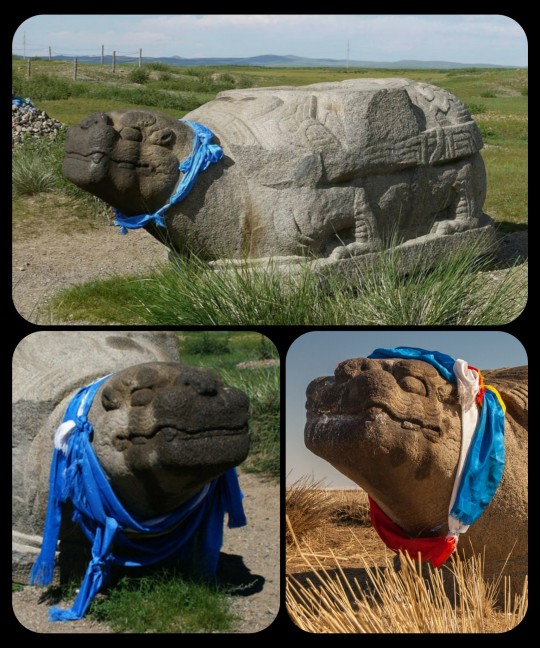
The statue is decorated with a ceremonial scarf known as a khadag (or khata), which is part of a Buddhist custom that is also found in Tibet, Nepal, and Bhutan. The scarves are often left atop shrines and sacred artifacts as a way to express respect and/or reverence. In Mongolia, this tradition also contains elements of Tengrism/shamanism.
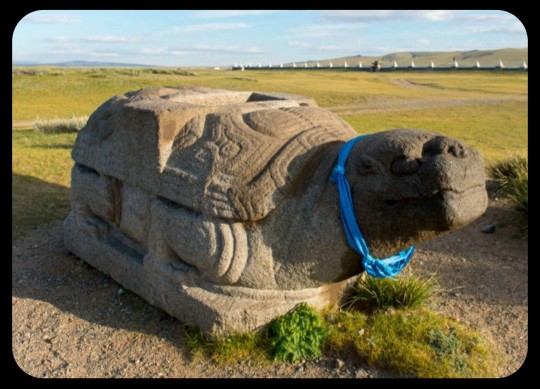
The city of Karakorum was originally established by Genghis Khan in 1220 CE, when it was used as a base for the Mongol invasion of China. It then became the capital of the Mongol Empire in 1235 CE, and quickly developed into a thriving center for trade/cultural exchange between the Eastern and Western worlds.
The city attracted merchants of many different nationalities and faiths, and Medieval sources note that the city displayed an unusual degree of diversity and religious tolerance. It contained 12 different temples devoted to pagan and/or shamanistic traditions, two mosques, one church, and at least one Buddhist temple.
As this article explains:
The city might have been compact, but it was cosmopolitan, with residents including Mongols, Steppe tribes, Han Chinese, Persians, Armenians, and captives from Europe who included a master goldsmith from Paris named William Buchier, a woman from Metz, one Paquette, and an Englishman known only as Basil. There were, too, scribes and translators from diverse Asian nations to work in the bureaucracy, and official representatives from various foreign courts such as the Sultanates of Rum and India.
This diversity was reflected in the various religions practised there and, in time, the construction of many fine stone buildings by followers of Taoism, Buddhism, Islam, and Christianity.
The prosperous days of Karakorum were very short-lived, however. The Mongol capital was moved to Xanadu in 1263, and then to Khanbaliq (modern-day Beijing) in 1267, under the leadership of Kublai Khan; Karakorum lost most of its power, authority, and leadership in the process. Without the resources and support that it had previously received from the leaders of the Mongol Empire, the city was left in a very vulnerable position. The residents of Karakorum began leaving the site in large numbers, until the city had eventually become almost entirely abandoned.
There were a few scattered attempts to revive the city in the years that followed, but any hope of restoring Karakorum to its former glory was then finally shattered in 1380, when the entire city was razed to the ground by Ming Dynasty troops.
The Erdene Zuu Monastery was later built near the site where Karakorum once stood, and pieces of the ruins were taken to be used as building materials during the construction of the monastery. The Erdene Zuu Monastery is also believed to be the oldest surviving Buddhist monastery in Mongolia.
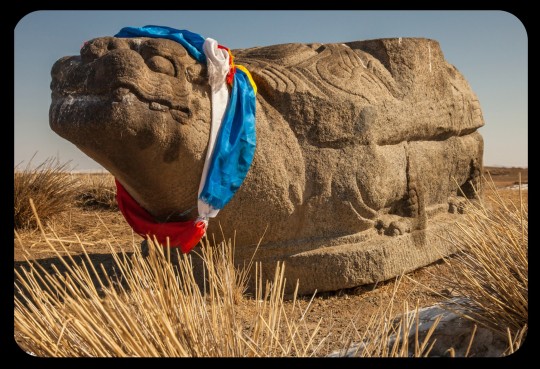
There is very little left of the ruined city today, and this statue is one of the few remaining features that can still be seen at the site. It originally formed the base of an inscribed stele, but the pillar section was somehow lost/destroyed, leaving nothing but the base (which may be a depiction of the mythological dragon-turtle, Bixi, from Chinese mythology).
This statue and the site in general always kinda remind me of the Ozymandias poem (the version by Horace Smith, not the one by Percy Bysshe Shelley):
In Egypt's sandy silence, all alone,
stands a gigantic leg
which far off throws the only shadow
that the desert knows.
"I am great OZYMANDIAS," saith the stone,
"the King of Kings; this mighty city shows
the wonders of my hand."
The city's gone —
naught but the leg remaining
to disclose the site
of this forgotten Babylon.
We wonder —
and some Hunter may express wonder like ours,
when thro' the wilderness where London stood,
holding the wolf in chace,
he meets some fragment huge
and stops to guess
what powerful but unrecorded race
once dwelt in that annihilated place
Sources & More Info:
University of Washington: Karakorum, Capital of the Mongol Empire
Encyclopedia Britannica: Entry for Karakorum
World History: Karakorum
#archaeology#history#anthropology#artifact#ancient history#mongol empire#mongolia#karakorum#middle ages#ancient ruins#art#turtle#bixi#ozymandias#poetry#mythology#genghis khan
248 notes
·
View notes
Text

ꜰꜰxɪᴠ ɢʟᴀᴍᴛᴏʙᴇʀ ▶ ᴅᴀʏ 2 ↳ autumn
Cooler days approach as the trees bare their branches, and out come the longer sleeves and taller boots. Still the Warrior of Light declines to wear pants. Her companion, retired from her brief role as an honorary Scion, prefers to don a more civilian garb rather than dress for the battlefield.
Alannah (left):
Valerian Shaman's Temple Chain
Bozjan Coat of Healing (Pearl White)
False Nails (Pearl White)
Guardian Corps Skirt
YoRHa Type-53 Thighboots of Healing (Loam Brown)
Brina (right):
Baronial Jacket (Slate Grey + Jet Black)
Saigaskin Halfgloves of Gathering (Jet Black)
Varsity Skirt (Jet Black)
Far Eastern Maiden's Boots (Jet Black)
#ffxivglamtober2024#ffxiv#alannah corvaine#brina cross#screenshots#the problem with bozjan gear is that the leather is very nice and detailed and barely anything else in the game matches it
48 notes
·
View notes
Photo

Buddhism in Ancient Korea
Buddhism, in Korean Bulgyo, was introduced by monks who visited and studied in China and then brought back various Buddhist sects during the Three Kingdoms period. It became the official state religion in all Three Kingdoms and subsequent dynasties, with monks often holding important advisory roles in governments. Korean Buddhism came to be much more inclusive than in other cultures with significant attempts made by important Buddhist scholars to reconcile the many diverging branches of the religion. Buddhism would have a profound influence on Korean art, literature, and architecture from bells to pagodas, ceramics, sculpture, and even developments in printing techniques.
Introduction From China
According to tradition, Buddhism was introduced first to the kingdom of Goguryeo (Koguryo) in 372 CE, followed by Baekje (Paekche) in 384 CE, and finally in the Silla kingdom between 527 and 535 CE. The first monk to bring Buddhist teachings was Sundo, who was sent for that purpose by the ruler of Eastern Qin, Fu Jian. It was hoped that stronger cultural ties with Goguryeo would lead to more practical cooperation in meeting the military threat posed by hostile Manchurian tribes. A decade later, Marananta, an Indian or Serindian monk, came from the Eastern Jin state and taught Buddhism in the Baekje kingdom. In both states, the new faith received a favourable reception. In the Silla kingdom, though, Buddhism was seen as a threat to the traditional religions of shamanism, animism, and ancestor worship, and not until the martyrdom of the monk Ichadon was Buddhism finally accepted and then promoted by the royal court.
Continue reading...
33 notes
·
View notes
Text
I'm throwing my crystal ball at the next Westerner/white person who opens their mouth about shamanism.
I'm not kidding, I swear to the gods and my Tungusic ancestors.
#shamanism#tungusic people#eastern spirituality#witches of color#white people's bullshit#westerners' bullshit#cultural appropriation#closed practices#women of color
20 notes
·
View notes
Text
Prophecy And Symbolism of Eastern Grass Owl
The Following Channel is from higher powers, Divine, the ancestral plane and is prophetic through Quornesha S. Lemon|
Whether the Eastern Grass Owl appears in dreams, visions, waking life or synchronicities, it is a sign and message that you’re safe, protected and guarded by divine forces that help battle lower frequencies on your behalf. A traitor will be exposed and the authorities of the spirit will see the truth. You are more powerful than you were before. Your confidence is on another level, as well as your love. Your thoughts are highly regarded and you confuse your enemies. The prosperity of the wicked will come to you. Divine will alchemize all that opposes you and put blessings into your hand instead of what the enemy desires.
You are a force to be reckoned with and you walk so gracefully that the only thing/being that can humble you is God/Divine. You can rest assured that the next chapter of your life is that of being unbothered, unhindered and unstoppable. Not only do your ancestors trust and love you. but other people’s ancestors love you as well. You honor people that you have never met before. Your heart is golden.
This message isn't, obviously resonant with all whose paths it crosses, as perhaps you may encounter someone of this vernacular, mastery or skill. Therefore, it is a sign from the universe that you're meant to work with such a person. What was once a threat will subside. Pay attention to an increase in your finances or salary. You are watched over by higher powers. You are loved in many realms and some of these very realms fear to try you in a malevolent way.
To Go against you is to go against God/Divine. You are about to, if you have not already are about to be gifted with sight to commune with forces beyond the control of the ordinary and you will have authority over it all. You will have a grace and favor over your life. Dead goals and dreams will be resurrected. New passions will arise. It’s time you live in a paradise of your own. Your instincts will begin to be right on the money. Pinpoint even. A shift has occurred that no one can undo. NO power in heaven/hell can nullify.
Need further clarity or your own queries answered? Book your own reading as my schedule is full and I do not guarantee a reply on social media regarding this post.
If this is not you, then it is time to get clear to rejoin your tribe or the rest of the world of infinite beings. It's time to bring your light to the forefront. However, if you aren't able to invoke, heal or otherwise on your own, call on the assistance of shamans, healers, intuitive people, etc. to assist you. This synchronicity can possibly have specific meanings for you, it's time to get insight.
The Gift that Quornesha Has can never be duplicated, She is a Shaman, Writer, Healer, And Teacher with incredible prophetic/healing gifts. Please do not infringe upon her rights as the author. You are not permitted to reuse, nor are you to sale as you wish. This information has been made available to you for the purpose of introduction and demonstration. All rights reserved. If you'd like to use this in a magazine, online publication, or other, please ask for permission first. Legal actions will be taken if you proceed to impose. Be blessed, bless others and be at peace on your journey. What you do is coming back on you. Make sure that it is good, and all is well within you, through you and around you. The source sees all and knows what you think it does not.
#Eastern grass owl prophecy#owl totems#totems#shamanism#shaman#mystic#mysticism#prophet#prophetic#intuitive#channeling#High priestess#high priestess#divine#dreams and their meaning#barn owls#the spiritual meaning of Eastern Grass Owl\#grass owl
2 notes
·
View notes
Text

Aum Agnaye Swaha!
Amanita Muscaria "Fly Agaric" Talon Abraxas
Fly Agaric in Mythology
Mythologies from around the world echo the enigma of the Fly Agaric. Everywhere it is seen as a semi-divine being and often it is associated with the mighty thunder gods and their cosmic fire. In India, for example, Fly Agaric is sacred to Agni, the god of fire. His devotees made sacrificial offerings of Fly Agaric while partaking of it as a sacrament. It is said to have helped them to commune with their god.
In Mayan dialects, Fly Agaric is known as ‘Kukulja’, which also means ‘thunder’. The Lacandon Maya call it ‘Eh kib lu’um’, which translates as ‘ the Light of the Earth‘ (Rätsch).
In parts of northern and Eastern Europe, it is sometimes called ‘Raven Bread’ in allusion to Woden’s companions. According to legend, the wise ravens were Woden’s constant companions. They would travel on his shoulders, whispering many a secret into his ears. Woden /Thor is a thunder-god. He is a wild, shamanic god of nature, who commands the elements. He gallops across the sky on his brave steed, Sleipnir, the eight-legged stallion, who runs swift as the wind and kicks up the storm clouds in his wake. As he gathers speed, foam forms at the horse’s mouth and drops to the earth. Magically, each drop of foam becomes a Fly Agaric.
In Western mythology, the Fly Agaric represents the archetypal mushroom – even people who know nothing about fungi recognize it at once. But, depending on their heritage, people are mostly conditioned to fear all mushrooms (a condition known as ’mycophobia’). Only the flavorless varieties found on supermarket shelves are believed to be edible. (This has changed a bit, in recent years, as Eastern Europeans, who love mushrooms, have brought their love of fungi with them as they migrated around Europe.
41 notes
·
View notes
Text
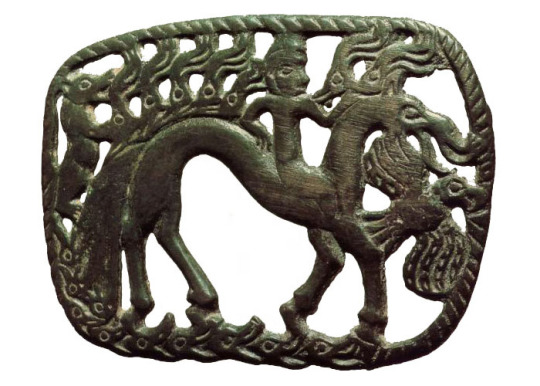
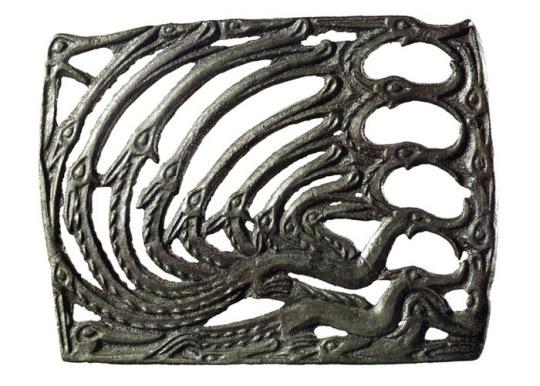
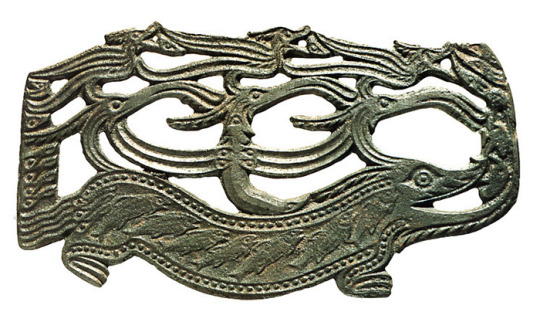
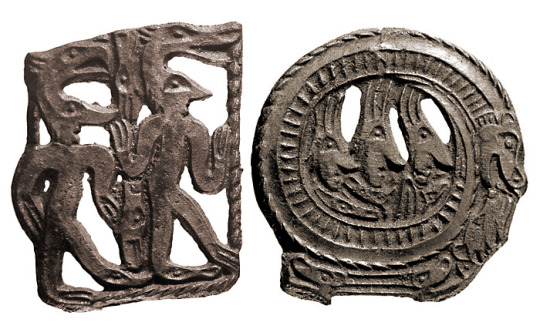
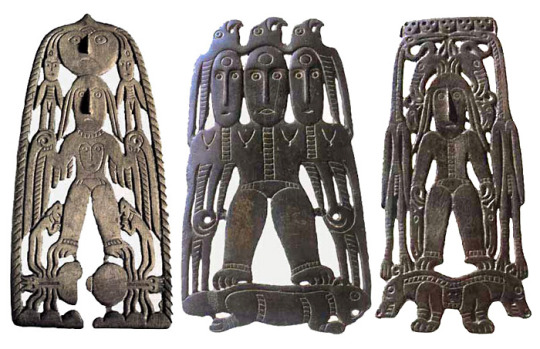
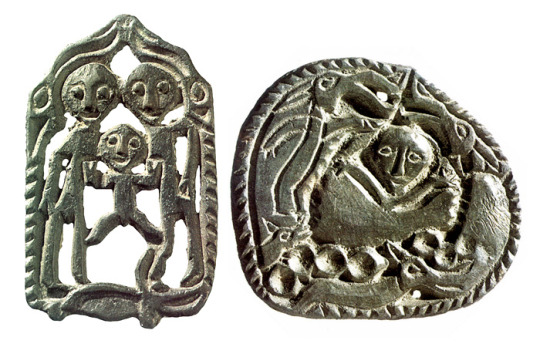
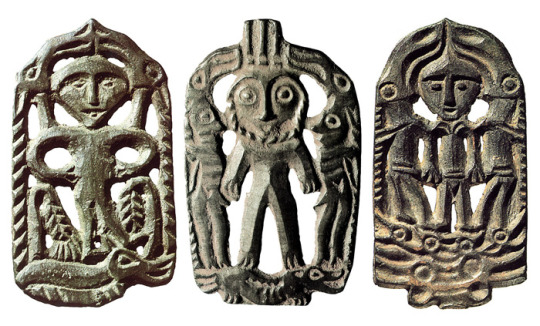
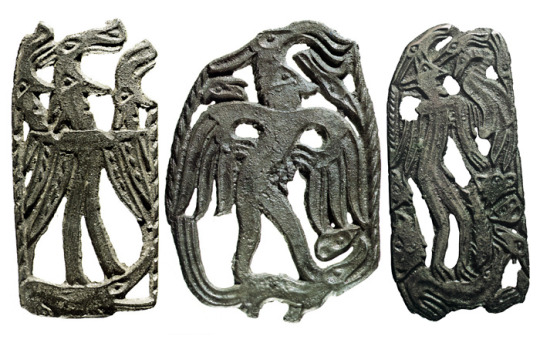
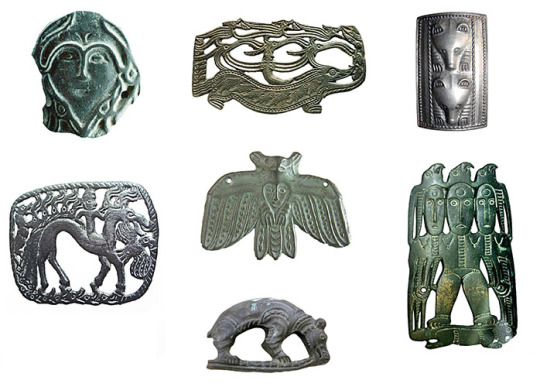
Permian animal style bronze plaques from the Ural mountain region of Russia. Dating from the 3rd to 12th centuries CE, they depict mythological stories and creatures from the shamanic tradition native to the region.
They have been found throughout a large area of forests in the north-eastern Urals and western Siberia from the basins of the Kama and Vyatka to the Ob. In the Middle Ages, these territories were inhabited mostly by the Ugrian tribes, ancestors of the present day Hungarians and Ob-Ugrians – the Khanty and the Mansi people.
Researchers point to the influence of Scytho-Sarmatian animal style on the development of cult toreutics of the forests of the north: famous animal battle scenes, vertical model of the Universe in the form of three worlds – three levels of the plaques and the cult of the great mother-goddess are present in both styles. Perm animal style objects include metalwork of bronze with the usage of single- or double-sided forms for casting, bone and wooden carvings, engravings on metal and bone objects. Figures depicted on the images are elks, rain-deers, bears, fur-bearing and other types of animals, horses, different waterfowl and birds of prey, snakes, insects and a number of "complex creatures" of mixed nature (hybrids), mixed zoomorphic and anthropomorphic half-human creatures; there are also a number of images of horsemen. The stories, which the Perm animal style plaques tell, are numerous and diverse.The objects are found in the hoards, on the sites of the temples, among the skeletons, in burials, as part of sacrificial complexes or on the sites of metallurgical workshops. Most of the bronze artifacts were used as a cult figures for the sacred rites.
513 notes
·
View notes
Text
✧༺┆✦The Matriarchal Societies✦┆༻✩

Matriarchal societies, where women occupy primary power roles in political, social, and economic realms, have existed across various cultures and historical periods. Distinguished by matrilineal descent, communal decision-making, and significant female authority, these societies present alternative models of social organization.
Characteristics of Matriarchal Societies
Matrilineal Descent
A hallmark of matriarchal societies is matrilineal descent. Family lineage, property, and titles are inherited through the mother’s line, ensuring continuity and stability as women control familial and economic resources. Matriarchs play central roles in family organization, often making key decisions about marriage, property distribution, and household management.
Political Authority
Women in matriarchal societies frequently hold significant political positions such as chiefs, queen mothers, or council leaders. Their leadership is active and involves governance and decision-making. Community councils, typically composed of elder women, guide community policies and resolve disputes, ensuring that women's perspectives are central to governance.
Economic Control
Women typically control property and land, managing and passing them down to their daughters. This economic power underpins their social authority and community status. They oversee the allocation of resources within the community, ensuring equitable distribution and the well-being of all members.
Cultural and Spiritual Roles
Women often serve as spiritual leaders, shamans, or priestesses, conducting important rituals and ceremonies. As custodians of spiritual knowledge and cultural traditions, women preserve and transmit cultural heritage through storytelling, education, and ritual practices, maintaining the community's identity and values.
Historical and Contemporary Examples
The Hopi (Native Americans)
The Hopi people, residing in north-eastern Arizona, follow a matrilineal system where clan membership and inheritance pass through the female line. Women own the land and homes, and they play significant roles in agricultural activities. Female elders influence decision-making processes, particularly regarding community welfare and cultural traditions.
The Ashanti (West Africa)
The Ashanti people of Ghana practice a matrilineal system in which lineage and inheritance pass through the mother's line. The Queen Mother holds significant political influence, including the authority to select the Asantehene (king). Women are key figures in trade and local markets, controlling the distribution of goods and resources.
The Baganda (Uganda)
In Buganda, a kingdom within Uganda, women hold crucial roles in the matrilineal descent system. The Namasole (queen mother) has substantial political influence and advises the Kabaka (king). Women manage household economies, control land inheritance, and are active in agricultural production, ensuring the community's sustenance.
The Mosuo (China)
Located near Lugu Lake in the Yunnan and Sichuan provinces, the Mosuo people practice a unique form of matrilineal descent. Extended families live in large households managed by the matriarch. The Mosuo have "walking marriages," where men visit their partners at night and return to their maternal homes in the morning. Children remain with their mothers, and maternal uncles play significant roles in their upbringing. Women control the household economy, manage agricultural activities, and are involved in local trade and tourism.
The Khasi (India)
The Khasi people of Meghalaya in north-eastern India follow a matrilineal system where property and family names are inherited through the female line. The youngest daughter, known as the "Ka Khadduh," inherits the ancestral property and is responsible for taking care of the elderly parents. Khasi women play central roles in household management, local commerce, and cultural rituals.
The Igbo (Nigeria)
Among the Igbo people of Nigeria, certain communities practice matrilineal descent, particularly in the inheritance of property and titles. Women are influential in trade and local markets, actively participating in community decision-making processes. Female-led organizations and associations play crucial roles in maintaining social order and cultural traditions.
The Minangkabau (Indonesia)
The Minangkabau, located in West Sumatra, are the world's largest matrilineal society. Property and family names are inherited through women. Women manage the household and family inheritance, while men handle external political relations. The role of "Bundo Kanduang" (the revered mother) symbolizes female authority and wisdom. Women play central roles in cultural ceremonies, such as weddings and funerals, reinforcing their social status and authority.
The Tuareg (Sahara Desert)
The Tuareg people, living in the Sahara Desert across Mali, Niger, Algeria, and Libya, practice matrilineal descent. Property and family tents are inherited through the female line. Women have significant autonomy and can initiate divorce. They control family wealth and manage household affairs. Women are custodians of the family's history and traditions, passing down cultural knowledge through oral traditions and music.
The Trobriand Islanders (Papua New Guinea)
The Trobriand Islanders of Papua New Guinea follow a matrilineal system where lineage and inheritance are passed through the mother’s line. Women control the distribution of yam, a staple crop that signifies wealth and social status. Female leaders, known as "dauk," play essential roles in community decision-making and cultural rituals.
The Iroquois Confederacy (North America)
The Haudenosaunee (Iroquois) society, located in the north-eastern United States, is matrilineal, with clans led by elder women known as Clan Mothers. Clan Mothers have the authority to nominate and depose male leaders (sachems). They play a vital role in maintaining the Great Law of Peace, which governs the confederacy. Women are central to agricultural practices, growing the "Three Sisters" crops (corn, beans, and squash), which are crucial to the community's sustenance.
Modern Implications and Interpretations
Matriarchal societies offer models of gender equality and demonstrate that societies can thrive with women in central roles. These societies challenge the notion that patriarchal structures are necessary for social stability. The emphasis on matrilineal descent and female authority helps preserve cultural traditions, ensuring the continuity of community identity. Women's control over resources often leads to more sustainable and equitable economic practices, benefiting the community as a whole.
Challenges and Misconceptions
Common misconceptions suggest that matriarchal societies simply reverse the power dynamics of patriarchy, with women dominating men. However, these societies often emphasize balance, cooperation, and mutual respect between genders. Patriarchal societies may resist the idea of matriarchy, viewing it as a threat to established power structures, leading to the marginalization and misrepresentation of matriarchal communities.
Matriarchal societies provide valuable insights into alternative social structures where women hold central roles in political, social, and economic spheres. These societies demonstrate the viability of matrilineal and matriarchal systems, offering models for more balanced and equitable gender dynamics. Understanding these societies broadens perspectives on power distribution, gender roles, and cultural practices, challenging the dominance of patriarchal paradigms in historical and contemporary contexts. They highlight the potential for diverse forms of social organization that prioritize cooperation, sustainability, and equality.

25 notes
·
View notes
Link
0 notes